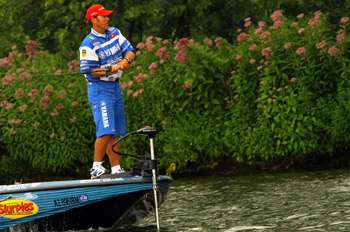
Part 2: Tackle and Tricks
Tackle matters when you're frog fishing. If you doubt that, ask Dean Rojas, the nation's leading frog angler.
"Tackle is critical in bass fishing, we all know that. But it's especially important when throwing frogs because of their unique characteristics," he explains. "Your rod, reel and line can mean the difference between weighing bass at the end of the day and lamenting the one that got away."
Rojas begins with a medium-heavy, Quantum Dean Rojas Tour Edition PT Signature Series rod. (Model PTC706FDR) To that he mounts a Quantum Tour Edition PT Burner reel. (7:1 gear ratio) spooled with 65-pound-test Izorline braid.
"My signature series rod is designed for frogs. It has a tough, heavy backbone and a fast tip. This helps with casting accuracy and when it comes time to set the hook. You need power to bring the bass in but you also need some flex — forgiveness — in the tip. This rod has both.
"The high-speed reel is every bit as important as the rod. More often than not the bass will swim towards you after the strike and hookset. You've got to gather the line in quickly if you expect to maintain control. There's no substitute for that 7:1 gear ratio.
"And, I'm talking about line last but that doesn't mean it's the least important. It's the link between you and the fish; neverskimp or cut corners with fishing line — never. If you're fishing my frog where you should be you'll encounter lots of things that will nick and fray it. Heavy Izorline is a must. It'll hold up when you need it to hold up."
After selecting tackle, it's time to go fishing. Rojas covered the basics in Part 1. Here he'll offer a few advanced tips that'll help us build on those basics.
1. Learn to cast.
"Frog placement is critical. If you miss a spot by only a few inches you'll likely come home empty-handed. Practice until you can put your bait exactly where you want it — every time. You should be able to flip, pitch and skip a frog in your sleep.
"Skipping is especially important. You can't flip, pitch or cast into many of the best places to fish a frog. Learn to skip with pinpoint accuracy and without backlashing your reel. You need to get back, under docks and overhanging limbs as well as between and around cover."
2. Go where no lure has gone before.
"I designed this lure to fish heavy cover, the impossible stuff. It's doesn't hang easily. Don't be afraid to throw it into places you wouldn't throw anything else. And remember, if you're using heavy Izorline you can pull hard without fear of a break-off. Fish your Bronzeye Frog in water that no one else can get to … or even thinks about."
3. Walk the frog.
"If you are having trouble walking this bait, clip about 3/4-inch off the legs. That'll help a lot and make walking it a lot easier."
4. Stop and hesitate before you set the hook.
"Don't get in a hurry when you get a strike. This is probably the biggest mistake most anglers make when they're frog fishing. Wait at least a couple of seconds after the strike before you set the hook. Allow the bass to get the bait in his or her mouth before you try to cross its eyes and drive the hook home.
"I know it's not easy. This is topwater fishing at its best. The explosions are dramatic and nerve jarring. But you've got to do it. If you snap the rod too quick, you'll pull the lure back before the bass really has it and all you'll get are regrets."
5. Think depth, not season.
"This is a shallow water lure, not a spring or fall lure. Throw it when bass are shallow without regard to the calendar. I won in New York on Oneida Lake. It was August."




